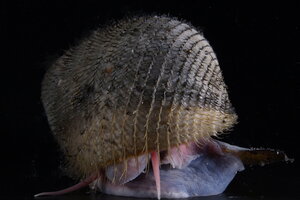Deep-sea virus hijacks bacteria's DNA
In the hot, dark plumes rising from hydrothermal vents on the ocean floor, scientists have found viruses pillaging sulfur from bacteria, by forcing them to read foreign DNA.

A hydrothermal vent snail (Alviniconcha sp.) found in Suiyo Seamount, Tokyo Hydrothermal Vent, is seen in this undated handout picture. Researchers have now understood how the bacteria at the bottom of food chains like these, are pillaged for their sulfur by deep-sea viruses.
Reuters
At various points along the bottom of the Pacific Ocean, where hydrothermal vents belch boiling water into depths a mile beneath the surface, strange creatures – six-foot-long tube worms, sidling crustaceans, and clouds of bacteria – cluster around the heat and minerals.
In these dark communities, the web of life works a bit differently than it does on land. Rather than converting sunlight to energy, the simplest organisms have evolved to convert minerals to energy, in a process known as chemosynthesis.
Using an unmanned submarine from the Woods Hole Oceanographic Institute, scientists collected DNA from six hydrothermal plumes, and discovered a previously unknown swashbuckling presence: bandit-like viruses that seize chemosynthetic bacteria and pillage their sulfur reserves, to power their own replication.
Similar relationships have been spotted before in photosynthetic microorganisms, but this is the first time viruses have been caught ravishing other life forms over an inorganic compound.
What’s most interesting about the finding is how the viruses work: rather than scooping up the SUP05 bacteria's sulfur globules and bounding away with them, scientists believe that the viruses are forcing the bacteria to consume their own sulfur, generating energy the viruses then gather, and use for their own reproduction. Almost as if mosquitoes, instead of absconding with their droplets of mammalian blood, tapped into our veins via direct drips to their own reproductive systems, and ordered us to generate nourishment for mosquito eggs.
Thankfully, that is one ability mosquitoes aren’t yet known to have. But, then, how do viruses pull it off?
The scientists found that the viral DNA includes genes that closely resemble bacteria's own genes, which they use to extract energy from stored sulfur. So, scientists suspect, they may actually be forcing bacteria to use familiar but foreign so-called “auxiliary metabolic genes.”
"There seems to have been an exchange of genes, which implicates the viruses as an agent of evolution," said Gregory Dick, a University of Michigan marine microbiologist, in a press release. “[The viruses] may serve as a reservoir of genetic diversity that helps shape bacterial evolution."
On a global scale, the finding “implicates viruses in the evolutionary dynamics of a central step in the planetary cycling of sulfur,” states the report, which was published in the May 1 issue of Science Express.
The understanding may help researchers predict how marine ecosystems will respond to global environmental changes.

